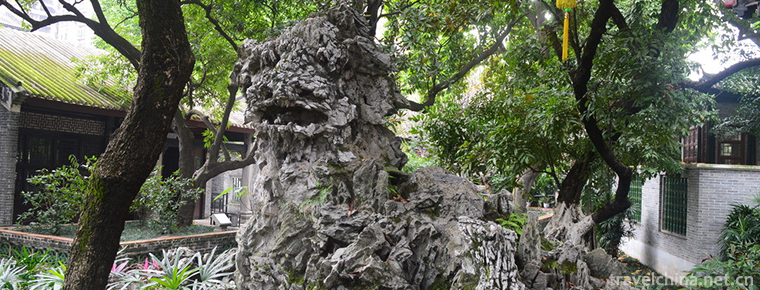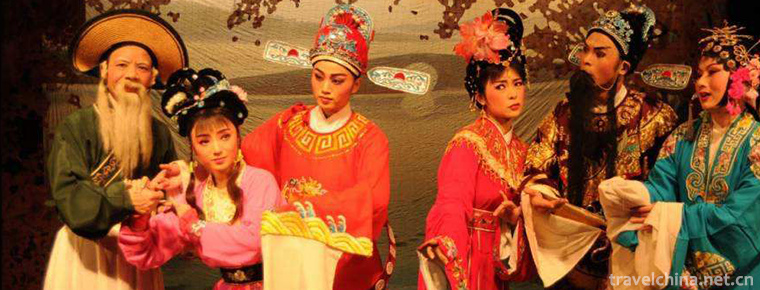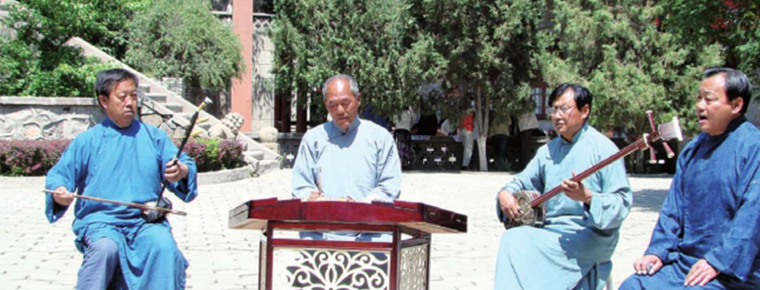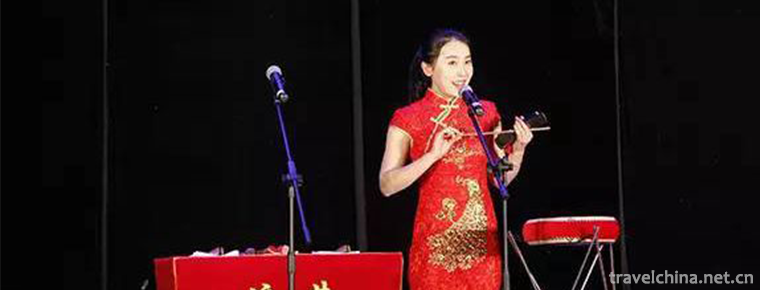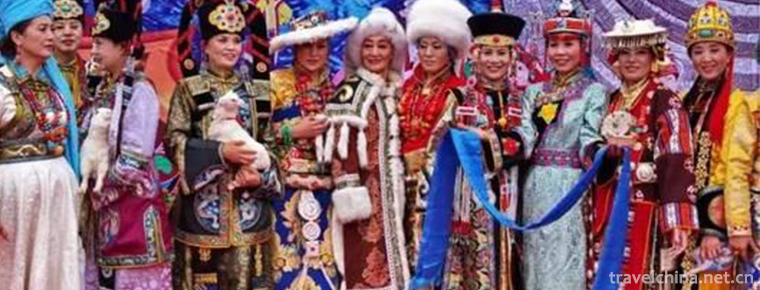Heluo drum
Heluo drum
Heluo Dagu, commonly known as "Shuoshu", is one of the traditional local songs in Henan Province.
Heluo Drum is a kind of traditional music that uses speaking and singing as artistic performance means, narrating stories, shaping characters, expressing thoughts and feelings, and singing social life. There are eleven kinds of lyrics and cards in its singing art form. The most representative traditional songs are "Liu Gong Case", "Doubles Roll", "Da Hong Pao", "Da Ba Yi" and "Xiao Ba Yi".
Heluo Drum originated from Yanshi of Henan Province, thrived in Gongyi, and was popular in Luoyang, Mengjin, Dengfeng and other places. On May 20, 2006, Heluo Dagu was approved by the State Council to be included in the first batch of national intangible cultural heritage list, project number V-12.
Historical evolution
Heluo Dagu, which originated in the late Qing Dynasty and the early Republic of China, is a younger kind of music popular in Heluo area. It has a history of one hundred years. According to the legend of the old artists, around 1900, a kind of piano book was popular in Luoyang area. Only the accompaniment of falling piano was played. The artist sat with his eyes closed, sang with a low voice and a slow rhythm, which was not very popular among the masses. After Nanyang Guer Ci artist Li Silai came to Luoyang, he performed with Qin and calligraphy artists. Qinshu artists absorb the advantages of Guer Ci artists'loud singing and action performances, as well as percussion music, Book drums and steel plates, which can set off the atmosphere and are very popular with the masses. After a long period of cooperation, the reform enriched the Luoyang Qinshu, and made the Luoyang Qinshu change qualitatively. A new kind of music, Dagushu, which is rich in the local flavor of Western Henan and popular with the masses, was gradually formed.
Heluo drum was popular in rural areas in the early years, and gradually spread to cities after the 1930s. In the mid and late 1930s, there was a fairly stable market for folk art in Luoyang city, and the competition among artists was fierce. From 1920s to 1940s, Heluo Drum began to prevail rapidly in Luoyang and the surrounding areas of Yanshi, such as Yiyang.
After the founding of New China, many of the existing guild systems of folk artists were gradually replaced by the state-approved and subsidized literary and artistic systems. In the new political and economic environment, the development of Heluo Drum has entered a new era. In 1950, Premier Zhou Enlai led a consolation delegation to the DPRK to offer condolences to the volunteers who resisted the US and aided the DPRK. Zhang Tianpei, a second generation drum-writing artist from Yanshi County, performed with the delegation. After watching the performance, Premier Zhou asked Zhang Tianpei, "What kind of music do you play?" Zhang answered, "This is our popular local folk art in Heluo area - Dagushu." Premier Zhou said, "Let's call it Heluo Drum!" According to Premier Zhou's suggestion, this form of folk art was officially named "Heluo Drum" at the first working conference of folk art held in Luoyang Special Zone in 1951.
The "Cultural Revolution" which began in 1966 brought a fatal blow to the development of traditional folk art throughout the country, including the Heluo Drum. The sudden change of political environment directly led to the suspension of almost all traditional folk art performances in Luoyang. From the late 1960s to the early 1970s, many traditional artists were criticized. It was not until 1977 that the situation of traditional folk art circles in Luoyang began to improve. The thawing of traditional folk art after the Cultural Revolution pushed Heluo Drum to a short peak. However, since the 1990s, Heluo Dagu has gradually been marginalized in cities and some suburban counties.
Popular area
The epidemic areas of Heluo drum are mainly in Luoyang, Yanshi, Gongyi, Mengjin and Dengfeng.
Inheritance and protection
Current situation
In the process of inheritance of Heluo Drum, there have been many well-known artists. Zhang Tiandou, the second-generation heir known as "the best scholar of storytelling", is almost well-known in Luoyang; Cheng Wenhe, the third-generation heir, is well-known in Western Henan, and has represented Henan in the first national Qu congress. A song "Zhaoyun Jiejiang" is appreciated by the national leaders; Duan Jieping, the fourth-generation heir, and Wang Xiaoyue, the former head of Henan Qu troupe, have established a school of their own and are well-known.
However, with the popularity of television, the audience of Heluo Drum has declined year by year, and the young people have no one to listen to and no one to learn. Especially the old artists who are old have passed away, and the number of artists has only declined, so the number of artists is less than 20. They are all over the age of five or sixty years, and most of them are no longer engaged in performing activities. In addition to the rise of new media, the changes in rural social life also make it more difficult to retain the tradition of Daguqu art in Heluo. With the acceleration of urbanization in the surrounding areas of Luoyang, many ceremonial and entertaining performances of the original Heluo Drum gradually disappeared. The living condition of Heluo Dagu has fallen into a worrying situation.
protective measures
1. Yanshi City, led by the Bureau of Culture, has set up "Heluo Dagu Protection and Development Leading Group", "intangible cultural heritage protection center" and "Heluo Dagu Census Working Group" with the staff of the "intangible cultural heritage protection center" as the backbone to conduct a general survey of the Heluo Dagu Project.
2. Since 2010, the Non-Heritage Declaration Center has cooperated with Luoyang TV Station to introduce the Heluo Drum in the column of "Heluo Bookstore". Every year, the Spring Festival Gala has Heluo Drum Program, which integrates the Heluo Drum with new elements such as singing and dancing performances and various forms of performance. He also actively cooperated with newspapers and news networks in Luoyang City to organize interviews on the protection and inheritance of non-heritage projects in Luoyang City, and launched the excellent inheritors of Heluo Drum in the program "Tiandi Luoyang" of CCTV.
3. In cooperation with Shenzhou magazine in 2008 and 2013, Luoyang Municipal Non-Heritage Center publishes two articles on the Heluo Dagu every month, mainly about the inheritance and protection of the Heluo Dagu, to raise public awareness of the importance of the protection of the intangible cultural heritage of the Heluo Dagu, and organizes various activities to guide the masses to appreciate the art of the Heluo Dagu.
4. In July 2014, Luoyang Museum of Culture established the "Heluo Drum Heritage Institute" for people to learn and exchange Heluo Drum. After the establishment of the institute, a series of propaganda activities were held, such as entering the community, organs and schools. Famous Heluo drum artists were invited to give wonderful performances to the people who love Heluo drum, and the people could enjoy them free of charge. It also invites well-known veteran artists to teach young people skills here, and allows more middle-aged and old people to have a place to appreciate the original Heluo drum in their memory.
Inheriting characters
Lu 4th generation
Art name "Lu Xinglin", male, Han nationality, born in February 1942, Dongcaizhuang Village, Shouling Township, Yanshi County, Luoyang City, Henan Province. In May 2006, Heluo Dagu was listed in the first national intangible cultural heritage catalogue of Quyi, project number v-12. In February 2008, the fourth generation of Lu was selected as the representative successor of the second batch of national intangible cultural heritage projects, which was declared by Luoyang City, Henan Province. From the age of 10, he followed his father to learn art, and later learned from Zhang Tiandou, the master of Heluo Drum. He was the fourth generation artist in Heluo. In 1958, by virtue of a section of Militia Battalion Commander, Lu Four Generations soon became popular in Yanshi County, and then he was transferred to the Yanshi Museum of Culture Quyi Team. Lu Four Generations sang with a loud voice, graceful movements and proper use of tuning doors. The accompaniment is particularly outstanding. Lu Four Generations also reformed the accompaniment system of Heluo Drum. In addition to the traditional musical instruments such as falling Hu and three strings, Erhu, Banhu and Pipa were added, which enriched the accompaniment music of Heluo Drum. In 1967, Lu Sisheng cooperated with his brother Duan Jieping to create famous passages such as "Plain Gun Shooting" and "Yellow River Surge". In the 1970s, Duan Jieping sang the Heluo Drum accompanied by Lu four generations. He participated in the National Quyi Festival three times in Jinjing, and recorded and broadcast it on the Central People's Broadcasting Station. Lu Sisheng is currently compiling and recording the repertoire of Heluo Drum. He has compiled more than 20 manuscripts, more than 50 book caps, more than 40 MIDDLE-LENGTH passages, 7 long books such as "Liu Gong Case", "Crying Red Lantern" and "Hui Cup Ji".
Selected non Heritage
On May 20, 2006, the "Heluo Drum" declared by Luoyang City, Henan Province, was listed in the first batch of national intangible cultural heritage list with the approval of the State Council. d

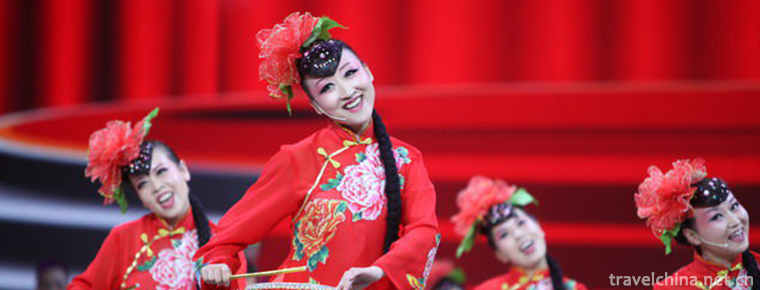
-
Lijiang River
The Lijiang River, a branch of the upper reaches of the Guijiang River.
Views: 84 Time 2018-10-12 -
Steamed Abalone with Sharks Fin and Fish Maw in Broth
Buddha jump wall, and the name of the altar full of fragrance, Fu Shing, is a famous local cuisine in Fuzhou, Fujian, belonging to the Department of Fujian cuisine. According to legend, it was develop.
Views: 258 Time 2018-11-02 -
Almond dew
Almond is a kind of vegetable protein beverage made from natural almond and mineral water. Its white like milk, delicate like jade, unique flavor, can be used as a substitute for ordinary milk.
Views: 154 Time 2018-11-08 -
Qinghui Garden
Qinghui Garden is an ancient garden building built in Ming Dynasty. Located in Qinghui Road, Daliang Town, Shunde District, Foshan City, Guangdong Province,.
Views: 203 Time 2019-02-07 -
Fengyang flower drum
Fengyang flower drum is also known as "flower drum", "beating flower drum", "flower drum gong", "double drum" and so on. Fengyang flower drum originated in Linh.
Views: 330 Time 2019-04-29 -
Taiwanese Opera
Gezi Opera, a local traditional drama in Zhangzhou and Xiamen, Fujian Province, is one of the national intangible cultural heritage..
Views: 277 Time 2019-05-01 -
Lanzhou drum
Lanzhou Drum, also known as Lanzhou Drum Ci and Lanzhou Quzi, is a popular folk form in Lanzhou area and one of the ancient Chinese Quyi. Lanzhou drum is a form of music art mainly composed of sitting.
Views: 185 Time 2019-05-10 -
Traditional Processing Techniques of Liuweizhai Sauced Meat
Liuweizhai is a well-known Chinese brand which was founded in 1738 in the three years of Qianlong in Qing Dynasty. Its sauced meat, as a traditional food in China and a famous food in the Three Jin Dy.
Views: 142 Time 2019-05-14 -
monologue storytelling accompanied by drumbeats
Plum blossom drum, born in the middle of the Qing Dynasty, originated in Beijing, is popular in Beijing and Tianjin. Before liberation, the sons and daughters of Beijing Banner People liked to sing me.
Views: 256 Time 2019-06-03 -
Mongolian Costume
Mongolian costumes, also known as Mongolian robes, mainly include gowns, belts, boots, jewelry and so on. However, there are differences in styles due to different regions. Mongolian costume has a str.
Views: 115 Time 2019-06-03 -
Cognitive Method of Life and Disease in Traditional Chinese Medicine
Cognitive method of life and disease of traditional Chinese medicine, one of traditional Chinese medicine, is declared by the Chinese Academy of Traditional Chinese Medicine and one of the national in.
Views: 157 Time 2019-08-03 -
Leshan population
By the end of 2018, the total number of household registration in Leshan was 1 million 269 thousand and 500, and the household registration population was 3 million 506 thousand and 800. Among them, 1 million 290 thousand and 600 were urban household registration.
Views: 381 Time 2020-12-17



